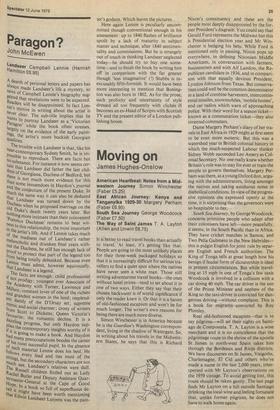Paragon?
John McEwen
Landseer Campbell Lennie (Hamish Hamilton £6.95) A dearth of personal letters and papers has always made Landseer's life a mystery, so news of Campbell Lennie's biography suggested that revelations were to be expected. Readers will be disappointed. In fact Lennie's motive in writing about the artist is never clear. The sub-title implies that he wants to portray Landseer as a 'Victorian Paragon' while the book often stresses, largely on the evidence of the early paintings, the artist's more buckish Georgian
qualities.
The trouble with Landseer is that, like his near-contemporary Sydney Smith, he is imPossible to reproduce. There are facts but no substance. For instance it now seems cer
tain that Landseer did father the last children of Georgiana, Duchess of Bedford, but there is not much more evidence for this than some innuendoes in Haydon's journal and the conjecture of the present Duke. In
Much the same way it can also be deduced that Landseer was turned down by the Duchess when he proposed marriage on the old Duke's death twenty years later. But nothing more intimate than their coinvented 'rummcs Duchesse' remains to bear witness to this relationship, the most important in the artist's life. And if Lennie takes much of the madness out of Landseer's rather melancholic and drunken final years without the Duchess, he still has enough lack of Proof to protect that part of the legend too from being totally debunked. Because even Lennie must admit, however equivocally, that Landseer is a legend. The facts are enough: child professional if not Prodigy; youngest ever Associate of the Academy with Turner, Lawrence and Millais; constant lover of one of the richest and grandest women in the land; resplendent dandy of the D'Orsay set; supreme mimic and social charmer ; crony of writers from Scott to Dickens; Queen Victoria's favourite; the romantic decline. It is a dazzling progress, but only Haydon supPlies the contemporary insights worthy of it if ft is going to make a book. And Haydon had many preoccupations besides the career of his most successful pupil. In the absence of such material Lennie does his best. He follows every lead and ties most of the strings, but the secondary characters are not .._rnuch use. Landseer's relatives were dull. The Russell children fizzled out as Lady tRachel Butler and Deputy Assistant Quarermaster-General at the Cape of Good raope. In a book so full of superfluous detil it might have been worth mentioning at Edwin Landseer Lutyens was the pain
ter's godson. Which leaves the pictures.
Here again Lennie is peculiarly uncommitted though conventional enough in his assessment : up to 1840 flashes of brilliance spoilt by a lack of maturity in subject matter and technique, after 1840 sentimentality and commissions. But he is strangely out of touch in thinking Landseer neglected today—he should try to buy one sometime—and to finish the book by writing him off in comparison with the far greater though 'less imaginative' ( !) Stubbs is inexcusably fifth-formish. It would have been more interesting to mention that Bonington was also born in 1802. As for the prose, such prolixity and uncertainty of style dressed all too frequently with clichés ill becomes an ex-Head of Scripts with Scottish TV and the present editor of a London publishing house.


































 Previous page
Previous page